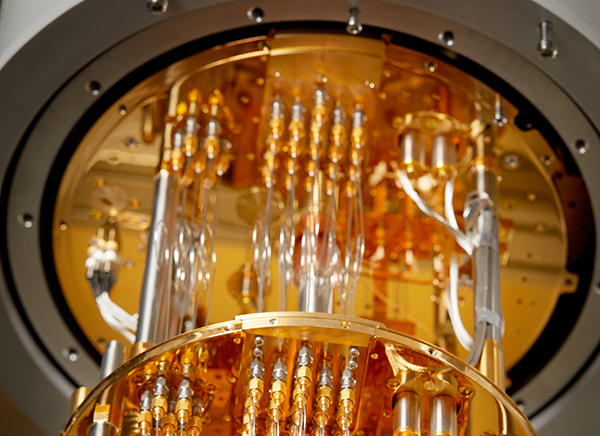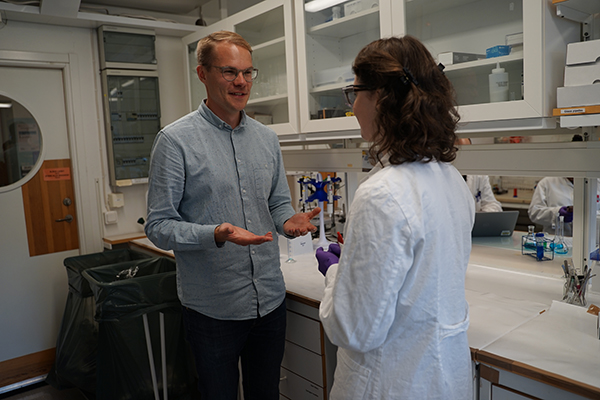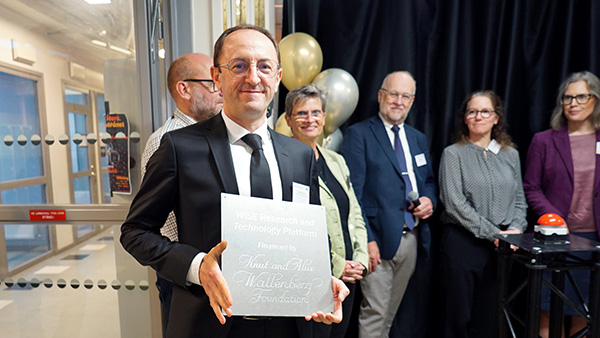16 Dec 2025
WISE supports solar cell research
Research on organic solar cells at Karlstad University is advancing with support from WISE.

19 Apr 2024
In a scientific breakthrough, researchers have successfully produced a sheet of gold that is only one atomic layer thick: goldene.
[The photo in the excerpt was taken by Olov Planthaber at Linköping University. Dr. Shun Kashiwaya (left) and Prof. Lars Hultman (right), communicating authors on the goldene report, discuss etching schemes for goldene extraction.]
Goldene belongs to the class of two-dimensional (2D) materials, crystalline solids with a thickness of just a few nanometers or less. In comparison to their bulk or three-dimensional counterparts, 2D materials often exhibit distinct properties. One of the most famous examples of 2D materials is graphene, a single layer of carbon atoms arranged in a honeycomb lattice. Much like graphene, goldene shows promising potential by offering unique properties that are different to those of gold. Its two-dimensional structure provides a high surface-area-to-volume ratio, along with an abundance of unsaturated atoms exposed on the surface, holding promise for enhanced catalytic properties. Moreover, the remarkable electronic properties of goldene offer potential benefits in diverse applications such as solar energy harvesting, carbon dioxide conversion, chemical production, hydrogen catalysis, water purification, and cancer treatment through plasmonic photothermal therapies.
The journey to create 2D metal materials, particularly gold monolayers, has not been easy. Gold atoms tend to form islands rather than continuous layers. Prof. Hultman found an old method employed by Japanese blacksmiths, known as Murakami’s reagent, which etches away carbon residues and changes the color of steel in, for example, knife manufacturing. However, it was not possible to use the exact same recipe and researchers had to fine-tune the procedure by a trial-and-error approach.
– We had created the basic material with completely different applications in mind. We started with electrically conductive ceramics called titanium silicon carbide, where silicon is interleaved as atomic layers. Then the idea was to coat the ceramics with gold to create a contact. Totally unexpectedly though, the silicon layer was replaced by gold inside the base material when the material was exposed to high temperatures, explains Prof. Lars Hultman at Linköping University and WISE researcher.
The researchers used computational modeling to demonstrate that two-dimensional goldene is inherently stable. Experiments however, revealed minor issues such as curling and agglomeration, which could be addressed by using surfactants.
– To the best of our knowledge, this is the first discovery of a free-standing two-dimensional one-atom-thick metal. The future is golden, enthuses Prof. Hultman.
The original publication in the journal Nature Synthesis entitled Synthesis of goldene comprising single-atom layer gold, can be found at: https://www.nature.com/articles/s44160-024-00518-4 (open access).
To learn more about Prof. Lars Hultman’s WISE project concerning two-dimensional tungsten layers used to make hard coatings, visit:
Eco-Deposition to Create Novel Multifunctional Coating Materials

16 Dec 2025
Research on organic solar cells at Karlstad University is advancing with support from WISE.

15 Dec 2025
On February 2, 2026, WASP and WISE will launch a joint call for proposals for five-year NEST projects.

11 Dec 2025
“Ce-based systems continues to surprise us in their unique physical and chemical properties, and the current discovery certainly should be placed under WISE thematic area Discovery, with hope to become a key ingredient in applications for sustainability”, says Prof. Eriksson from Uppsala University and WISE co-director.

5 Dec 2025
“For us it is important to work with sustainable materials and make sure that we manufacture them employing low-energy processes. We think from the beginning what elements we are going to use -their availability, price, recycling possibilities, etc.”, says Professor Thelakkat.

28 Nov 2025
The Uppsala node of the WISE Additive Research and Technology Platform (RTP) was officially inaugurated this week, marking a significant step in strengthening Sweden’s national research capacity in additive manufacturing.
Picture credit: Tobias Sterner, Bildbyrån

25 Nov 2025
Energy storage is one of the great scientific challenges of our time. To move toward a more sustainable society, we need batteries that are not only efficient but also environmentally responsible.

20 Nov 2025
Join us for the 7th Machine Learning Meets Materials Science Seminar, part of the WASP–WISE initiative! Mark your calendars: November 26 at 10:00!

17 Nov 2025
Uppsala University’s WISE Symposium series will spotlight cutting-edge sustainability research on November 26, 2025, with a webinar dedicated to the environmental aspects of additive manufacturing.

12 Nov 2025
On December 4, 2025, from 15:00 to 16:00, Uppsala University will host a WISE Guest Professor Lecture featuring Professor Julie Beth Zimmerman and Dr. Sandrine Lyonnard, both WISE Guest Professors at the university.

11 Nov 2025
“This talk explores the emerging frontier of biotechnology in enabling greener battery technologies, specifically through biohydrometallurgy and bio-based materials, ” says Prof. Srinivasan Nanyang from the Technological University (NTU), Singapore.

10 Nov 2025
As part of WISE’s Guest Professor (GP) program — one of our key initiatives to foster international collaboration and enrich student learning — we are delighted to welcome Professor Mette Rica Geiker from the Norwegian University of Science and Technology (NTNU) to Chalmers University of Technology.
Picture by Ann-Marie Thoresen at Statens Vegvesen

6 Nov 2025
The inauguration of the WISE Additive node at Linköping University (LiU) took place this week, marking an important milestone in the development of Sweden’s research infrastructure for additive manufacturing and soft electronics for sustainability.
Picture by Thor Balkhed, Linköping University

3 Nov 2025
The Guest Professor (GP) program is one of WISE’s recruitment and outreach activities, designed to foster international research collaborations and support the development of our students.

27 Oct 2025
The Wallenberg Centre for Quantum Technology (WACQT) and the Wallenberg Initiative Materials Science for Sustainability (WISE) have launched a new call for proposals — now open for applications!

23 Oct 2025
“Our society is increasingly dependent on technology. Take smartphones, for example: our entire lives are stored in them. Yet most of us are unaware of how energy-intensive their production processes are, how toxic or scarce some of the materials used in these devices can be, or how poorly many technologies are designed for recycling”, says WISE Guest Professor Federico Rosei at LTU.

22 Oct 2025
The Wallenberg Initiative Materials Science for Sustainability (WISE) seeks a Director of Sustainability to lead and develop the initiative’s strategic sustainability efforts.

20 Oct 2025
“I think it is important to observe and learn from nature. Nature does not waste. What one organism discards, another uses as energy. The key question for us is how we can minimize and reuse our own waste, how we can create more with less”, says WISE Guest Professor Alexander Bismarck from University of Vienna.

16 Oct 2025
We’re thrilled to kick off the WACQT-WISE Pilot Call 2025 with an inspiring webinar.

14 Oct 2025
—Quantum phenomena and materials science have once again demonstrated unique phenomena with the potential to benefit society, says Professor Olle Eriksson at Uppsala University, WISE Co-Director and Chair of the Nobel Committee for Physics.

9 Oct 2025
In a world increasingly powered by lithium-ion batteries—from smartphones to electric vehicles—the race is on to find cleaner, smarter ways to recover this critical metal.
Photo taken by Retain.

3 Oct 2025
On 2 October 2025, Chalmers University of Technology officially inaugurated its new additive manufacturing infrastructure: AM@Chalmers and the Chalmers WISE Additive node.

3 Oct 2025
The Wallenberg Centre for Quantum Technology (WACQT) and the Wallenberg Initiative Materials Science for Sustainability (WISE) are launching a new call to spark collaboration at the cutting edge of research.

2 Oct 2025
—Imagine a world where vehicles, buildings, and even everyday devices become self-powering, seamlessly merging structure and storage. This is the vision of structural power composites. Structural power composites open the door to a future where every part of a product contributes not only to its form and strength, but also to its function as an energy source, says WISE Guest Professor Madhavi Srinivasan from Nanyang Technological University.

25 Sep 2025
-Our role is to act as a bridge between PhD students, postdocs, and WISE Research School management. We receive questions and concerns both from students and postdocs as well as from the RS management, which we bring to our meetings for discussion, says Yamini Portes, chairperson of the WISE Student Council and PhD student at Stockholm University.

24 Sep 2025
Join us for the 6th Machine Learning Meets Materials Science Seminar, part of the WISE–WASP initiative! Mark your calendars: October 1 at 10:00!

24 Sep 2025
We’re pleased to announce that registration is now open for the AM4Life/WISE Additive Autumn School on the theme “Post-processing in AM and Surface Engineering.”

24 Sep 2025
We are pleased to welcome Professor Johan Hjelm, WISE Guest Professor at Lund University (LU), and Professor Yury Gogotsi, WISE Guest Professor at Linköping University (LiU), for a joint digital event on October 2, 2025, from 15:00 to 16:00.

17 Sep 2025
At WISE, we love to share the stories of the people driving science forward. Meet Professor Chao Zhang, an Associate Professor at Uppsala University who is passionate about reimagining the future of energy.

10 Sep 2025
–Materials science can never be done in “vacuum.” By this I mean that sustainability and circular economy must be considered from the very beginning, and this requires collaboration. No one can be an expert in everything, says WISE Guest Professor Mari Lundström from Aalto University.

2 Sep 2025
On September 11, 2025, from 15:00 to 16:00, WISE (Wallenberg Initiative Materials Science for Sustainability) will host a special guest professor lecture featuring two leading international researchers in materials science.